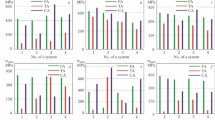With the help of the main concepts of computer engineering, we study the thermal and stressed state of the surface layer of ground Si3N4–TiC ceramics of four systems subjected to the action of heat flows. We analyze the regularities of temperature and stress distributions in six selected surfaces of the surface layer. We also determine specific features of formation of structural inhomogeneities of stresses and microstructural stress concentrators leading to changes in the structure of the ceramics due to the formation of discontinuities.





Similar content being viewed by others
References
Ch, Tian, N. Liu, and M. Lu, “Thermal shock and thermal fatigue behavior of Si3N4 – TIC nanocomposites,” Int. J. Refract. Met. Hard Mater., 26(5), 478 – 484 (2008).
W. Xu, J. Yuan, and Z. Yin, “Dynamic fatigue behavior of Si3N4-based ceramic tools materials at ambient and high temperatures,” Ceram. Int., 45(17), part A, 21572 – 21578 (2019).
H. Jiang, Zh. Xu, Z. Xiu, et al., “Effects of pulse conditions on microstructure and mechanical properties of Si3N4/6061Al composites prepared by spark plasma sintering (SPS),” J. Alloys Comp., 763, 822 – 834 (2018).
G.-D. Zhan, J.-L. Shi, T.-R. Lai, and T.-Sh. Yen, “Micromechanisms of creep-fatigue crack growth in α′–β′-SiAlON at 1200°,” J. Eur. Ceram. Soc., 17(10), 1267 – 1276 (1997).
M. Szafran, E. Bobryk, D. Kukla, et al., “Si3N4–Al2O3–TiC– Y2O3 composite intended for the edges of cutting tools,” Ceram. Int., 26(6), 579 – 582 (2000).
G. Bernard-Granger, J. Crampon, and R. Duclos, “High-temperature creep behaviour of β′-Si3N4 α-YSiAlON ceramics,” J. Eur. Ceram. Soc., 17(13), 1647 – 1654 (1997).
Y. Bao, Z. Jin, and L. Sun, “Strength degradation and lifetime prediction of HP- Si3N4/TiC under static load at 1200°C,” Mater. Lett., 45(1), 27 – 31 (2000).
V Kuzin, “A model of forming the surface layer of ceramic parts based on silicon nitride in the grinding process,” Key Eng. Mater. Precis. Machining, 496, 127 – 131 (2012).
J. Sun, H. Wang, Y. Wu, P. Zhou, et al., “Analysis of surface morphology and roughness of Si3N4 ceramic grinding,” Acad. J. Manufact. Eng., 16(3), 20 – 28 (2018).
V. V. Kuzin, “Technological aspects of diamond grinding of the nitride ceramics,” Russ. Eng. Res., 24(1), 23 – 28 (2004).
V. V. Kuzin, S. N. Grigor’ev, and S. Yu. Fedorov, “Evaluation of the reliability of ceramic tools with limited number of tests based on the established wear criteria,” Refract. Ind. Ceram., 59(4), 386 – 390 (2018).
V. V. Kuzin, “Increasing the operational stability of nitride-ceramic cutters by optimizing their grinding conditions,” Russ. Eng. Res., 23(12), 32 – 36 (2003).
V. V. Kuzin, S. Yu. Fedorov, and S. N. Grigor’ev, “Tribological aspect in technological assurance of ceramic component quality,” Refract. Ind. Ceram., 60(3), 280 – 283 (2019).
V. V. Kuzin, “Thermal state of ceramic cutting tools in high-speed cutting,” Russ. Eng. Res., 24(9), 32 – 40 (2004).
V. V. Kuzin, S. N. Grigoriev, and M. A. Volosova, “The role of the thermal factor in the wear mechanism of ceramic tools: Part 1. Macrolevel,” J. Friction Wear, 35(6), 505 – 510 (2014).
V. V. Kuzin, S. N. Grigoriev, and M. Yu. Fedorov, “Role of the thermal factor in the wear mechanism of ceramic tools: Part 2. Microlevel,” J. Friction Wear, 36(1), 40 – 44 (2015).
V. V. Kuzin, M. A. Volosova, and M. Yu. Fedorov, “Wear of tools from nitride ceramics when machining nickel-based alloys,” J. Friction Wear, 34(3), 199 – 203 (2013).
V. Kuzin, S. Grigoriev, and M. Portnoy, “Effect of thermal loading on stresses in defective surface layer of ceramics,” Appl. Mech. Math., 827, 189 – 192 (2016).
V. V. Kuzin, S. N. Grigor’ev, and M. A. Volosova, “Effect of a TiC coating on the stress-strain state of a plate of a high-density nitride ceramic under nonsteady thermoelastic conditions,” Refract. Ind. Ceram., 54(5), 376 – 380 (2014).
V. V. Kuzin, S. Yu. Fedorov, and S. N. Grigor’ev, “Correlation of diamond grinding regimes with Si3N4-ceramic surface quality,” Refract. Ind. Ceram., 58(1), 78 – 81 (2017).
V. V. Kuzin, S. Yu. Fedorov, and S. N. Grigor’ev, “Production process planning for preparing Si3N4 – ceramic objects taking account of edge defectiveness,” Refract. Ind. Ceram., 58(5), 562 – 565 (2018).
S. N. Grigoriev and V. V. Kuzin, “Prospects for tools with ceramic cutting plate in modern metal working,” Glass Ceram., 68(7/8), 253 – 257 (2011).
V. V. Kuzin, S. N. Grigor’ev, D. R. Burton, et al., “A new generation of ceramic tools,” in: Proc. of the Tenth Internat. Conf. on Manufacturing Research (ICMR) (2012), pp. 523 – 528.
V. V. Kuzin, S. N. Grigor’ev, and M. A. Volosova, “Basic framework for computer-aided engineering of ground ceramic surface layers,” Refract. Ind. Ceram., 61(3), 349 – 354 (2020).
V. V. Kuzin, S. N. Grigor’ev, and M. A. Volosova, “Force analysis of the stress-strain state of the surface layer of ground Si3N4–TiC-ceramics,” Novye Ogneupory, No. 12, 54 – 60 (2020).
V. V. Kuzin, S. N. Grigor’ev, and M. A. Volosova, “Microstructural model of the surface layer of ceramics after diamond grinding taking into account its real structure and the conditions of contact interaction with elastic body,” Refract. Ind. Ceram., 61(3), 303 – 308 (2020).
V. V. Kuzin and S. N. Grigoriev, “Method of investigation of the stress-strain state of surface layer of machine elements from a sintered nonuniform material,” Appl. Mech. Math., 486, 32 – 35 (2014).
Author information
Authors and Affiliations
Corresponding author
Additional information
Translated from Novye Ogneupory, No. 1, pp. 61 – 68, January, 2021.
Rights and permissions
About this article
Cite this article
Kuzin, V.V., Grigor’ev, S.N. & Volosova, M.A. Thermal Analysis of the Stress-Strain State of the Surface Layer of Ground Si3N4–TiC-Ceramics. Refract Ind Ceram 62, 60–66 (2021). https://doi.org/10.1007/s11148-021-00560-1
Received:
Published:
Issue Date:
DOI: https://doi.org/10.1007/s11148-021-00560-1




